-
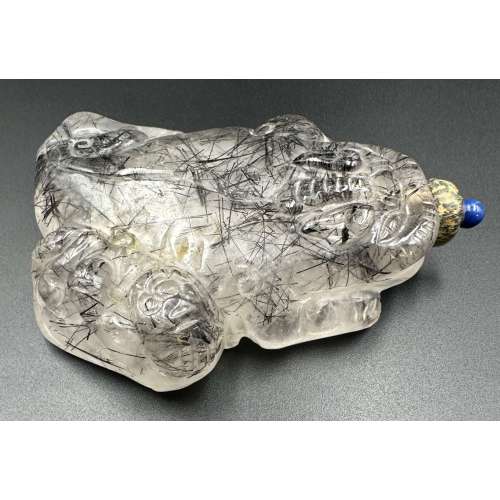 Snuff bottle in the form of Fo (or Fu) dog (lion-dog) guarding a cub carved of tourmalinated quartz with lapis lazuli and serpentine stopper. Late 19th century. Dimensions: L81 x W59 x H19 mm.
Snuff bottle in the form of Fo (or Fu) dog (lion-dog) guarding a cub carved of tourmalinated quartz with lapis lazuli and serpentine stopper. Late 19th century. Dimensions: L81 x W59 x H19 mm. -
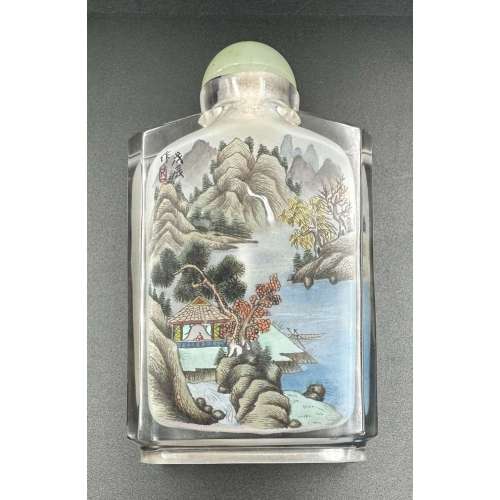 Large inside-painted glass snuff bottle with a mountain landscape design, signed and sealed Wu Chen Zuo, with a serpentine stopper. Mid-20th century. Dimensions: H105 x W61 x D27 mm.
Large inside-painted glass snuff bottle with a mountain landscape design, signed and sealed Wu Chen Zuo, with a serpentine stopper. Mid-20th century. Dimensions: H105 x W61 x D27 mm. -
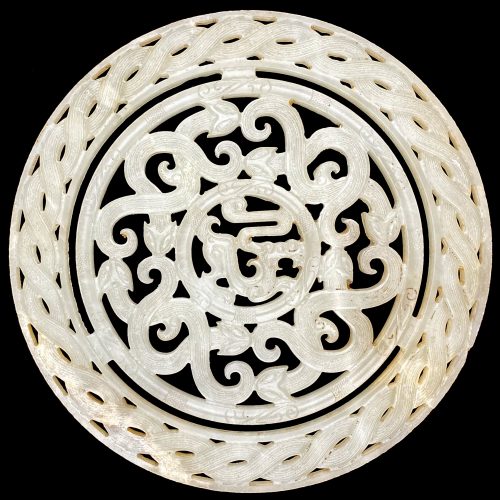 White jade Bi of three concentrical circles: double helix outer, intertwined serpents in the middle and a dragon in centre, carved in openwork and low-relief. China, the Ming Dynasty [大明] (1368 – 1644). Diameter: 15.9 cm; Height: 0.5 cm.
White jade Bi of three concentrical circles: double helix outer, intertwined serpents in the middle and a dragon in centre, carved in openwork and low-relief. China, the Ming Dynasty [大明] (1368 – 1644). Diameter: 15.9 cm; Height: 0.5 cm. -
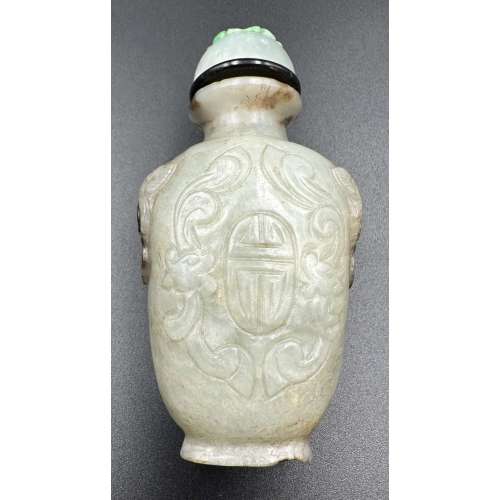 Jadeite snuff bottle carved with shou character and foo dog handles, with a black collar and jadeite stopper carved with a blossom design. Late 19th century. Dimensions: H74 x W39 x D26 mm
Jadeite snuff bottle carved with shou character and foo dog handles, with a black collar and jadeite stopper carved with a blossom design. Late 19th century. Dimensions: H74 x W39 x D26 mm -
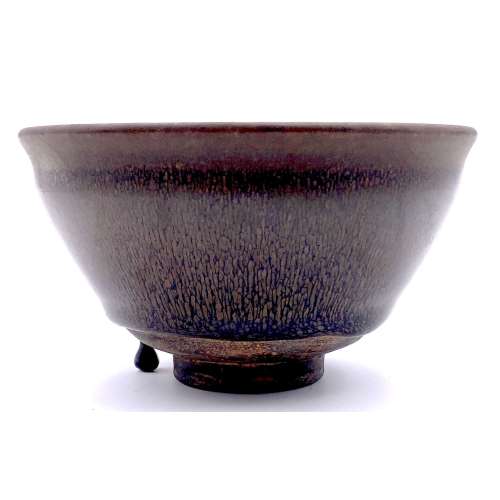 Brown bowl with golden-brown streaks on a black ground, mouth with a curved profile. A drop of glaze hanging in support. Base unglazed. In a wooden box. China, the Song dynasty [宋朝] (960 – 1279). Diameter: 12.5 cm; Height: 7 cm.
Brown bowl with golden-brown streaks on a black ground, mouth with a curved profile. A drop of glaze hanging in support. Base unglazed. In a wooden box. China, the Song dynasty [宋朝] (960 – 1279). Diameter: 12.5 cm; Height: 7 cm. -
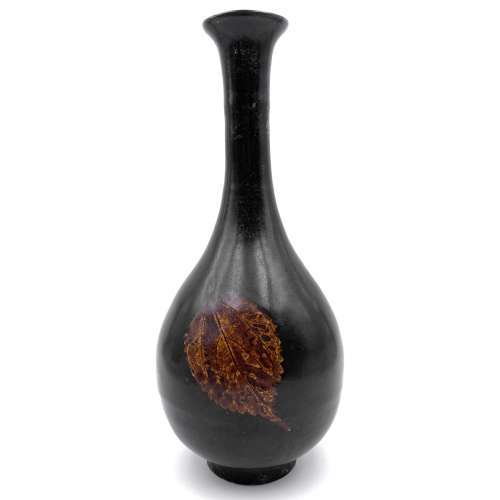 Jizhou black glaze bottle decorated with a leaf, placed on to the glaze before firing, and burnt away in the kiln to leave its pattern. Foot unglazed. China, the Song dynasty [宋朝] (960 – 1279). Height: 27.5 cm.
Jizhou black glaze bottle decorated with a leaf, placed on to the glaze before firing, and burnt away in the kiln to leave its pattern. Foot unglazed. China, the Song dynasty [宋朝] (960 – 1279). Height: 27.5 cm. -
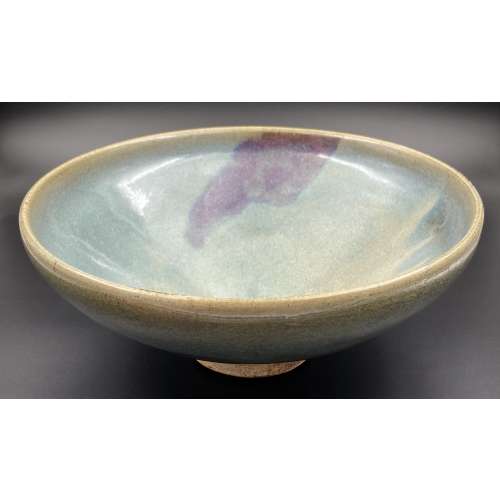 Bowl with tapered sides, lavender-blue glaze and a large purple splash on the interior; yellowish rim; foot unglazed. China, the Yuan Dynasty [大元] (1279 – 1368). Diameter: 21 cm; Height: 9 cm.
Bowl with tapered sides, lavender-blue glaze and a large purple splash on the interior; yellowish rim; foot unglazed. China, the Yuan Dynasty [大元] (1279 – 1368). Diameter: 21 cm; Height: 9 cm. -
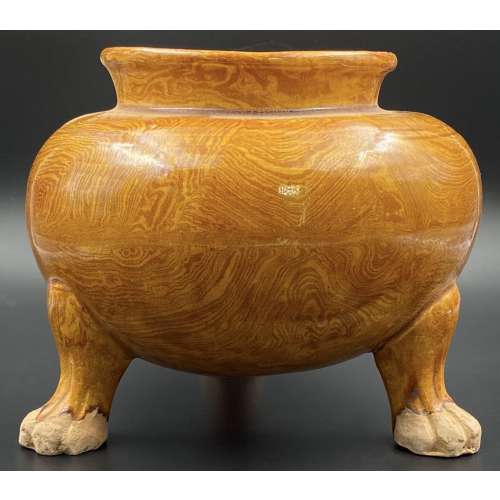 Amber-glazed marbled pottery tripod censer, standing on unglazed beast's paws. The clay itself is not marbled, only the glaze. China, the Tang dynasty [唐朝] (618 – 907). Diameter: 16 cm; Height: 14 cm.
Amber-glazed marbled pottery tripod censer, standing on unglazed beast's paws. The clay itself is not marbled, only the glaze. China, the Tang dynasty [唐朝] (618 – 907). Diameter: 16 cm; Height: 14 cm. -
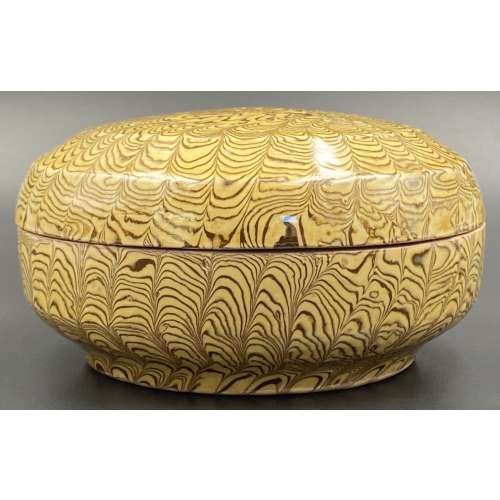 Press moulded round box with a cover made of yellow and brown marble clay, glazed with a clear glaze inside and outside. China, the Tang dynasty [唐朝] (618 – 907) Diameter: 11 cm; Height: 5.5 cm.
Press moulded round box with a cover made of yellow and brown marble clay, glazed with a clear glaze inside and outside. China, the Tang dynasty [唐朝] (618 – 907) Diameter: 11 cm; Height: 5.5 cm. -
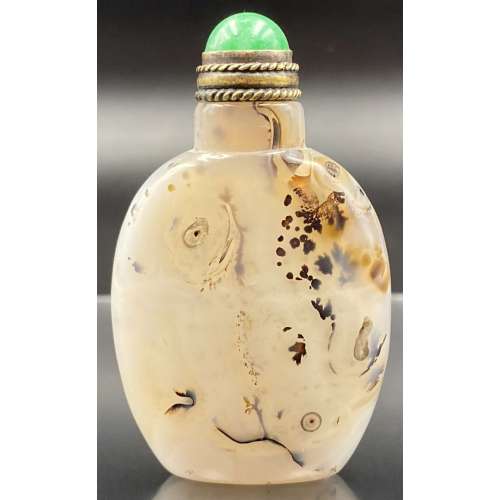 Agate snuff bottle of flattened rounded rectangular form, round neck, and flat base, semitransparent milky white body with dark brown inclusions of geometric form. Green jadeite stopper with a copper alloy spoon and collar. Qing dynasty [清] (1644-1912) Size: 7.2 x 4.3 x 2.2 cm
Agate snuff bottle of flattened rounded rectangular form, round neck, and flat base, semitransparent milky white body with dark brown inclusions of geometric form. Green jadeite stopper with a copper alloy spoon and collar. Qing dynasty [清] (1644-1912) Size: 7.2 x 4.3 x 2.2 cm -
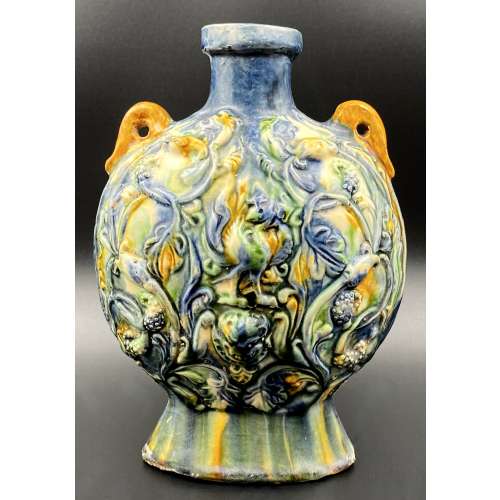 A vessel of flattened ovoid form supported on a tall splayed foot and surmounted by a short neck with the galleried rim. The shoulders set with a pair of loop handles, the body moulded on both sides with a Phenix surrounded with meandering floral and foliate scrolls. Covered with irregular splashes of green, amber, cream, and blue glazes, dripping down the foot. Foot bottom unglazed (beige body). China, the Tang dynasty [唐朝] (618 – 907). Height: 18.5 cm; Width: 13 cm
A vessel of flattened ovoid form supported on a tall splayed foot and surmounted by a short neck with the galleried rim. The shoulders set with a pair of loop handles, the body moulded on both sides with a Phenix surrounded with meandering floral and foliate scrolls. Covered with irregular splashes of green, amber, cream, and blue glazes, dripping down the foot. Foot bottom unglazed (beige body). China, the Tang dynasty [唐朝] (618 – 907). Height: 18.5 cm; Width: 13 cm -
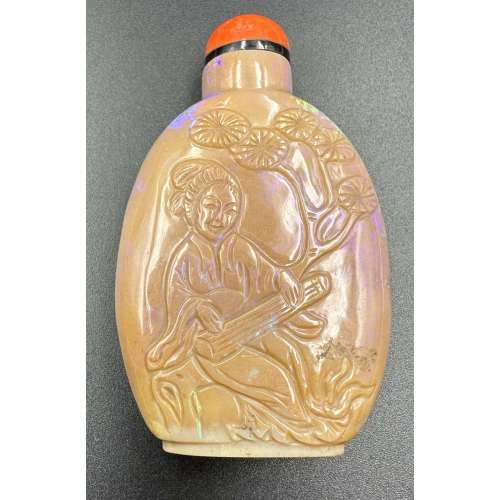 Opal jasper snuff bottle carved in low relief with a beauty playing Guqin under a pine tree and another on the veranda with a folding fan; bamboo, pine, and plum (the three friends of winter); carnelian agate stopper and black collar. Mid-20th century Dimensions: H67 x W41 x D15 mm
Opal jasper snuff bottle carved in low relief with a beauty playing Guqin under a pine tree and another on the veranda with a folding fan; bamboo, pine, and plum (the three friends of winter); carnelian agate stopper and black collar. Mid-20th century Dimensions: H67 x W41 x D15 mm -
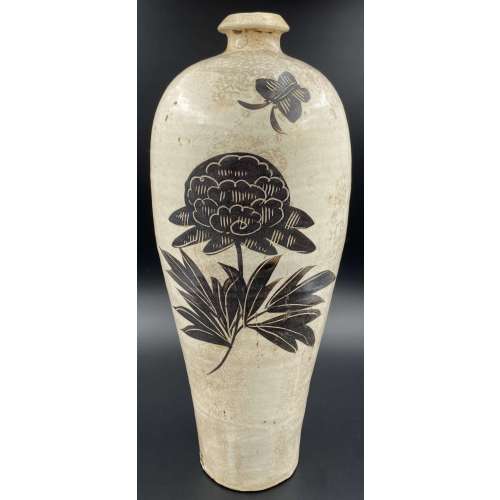 Typical meiping body, short neck, lipped rim; painted in the blackish-brown slip with two blossoms and butterflies under a clear glaze. The foot ring is unglazed exposing the brown body. China, the Yuan Dynasty [大元] (1279 – 1368). Diameter: 14 cm; Height: 30.5 cm.
Typical meiping body, short neck, lipped rim; painted in the blackish-brown slip with two blossoms and butterflies under a clear glaze. The foot ring is unglazed exposing the brown body. China, the Yuan Dynasty [大元] (1279 – 1368). Diameter: 14 cm; Height: 30.5 cm. -
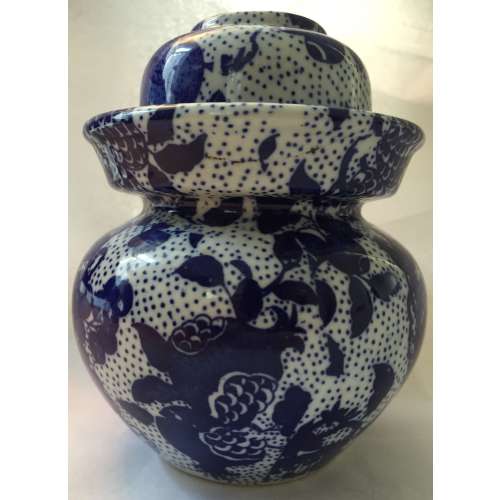 SOLD A Chinese vessel with pomegranates and grapes, of two parts - the vessel and a cup. Blue and white porcelain, decorated under the glaze with a blue pigment by transfer-printing. Imperial reign mark on the bottom in zhuanshu script: Qianlong (1736-1795).
SOLD A Chinese vessel with pomegranates and grapes, of two parts - the vessel and a cup. Blue and white porcelain, decorated under the glaze with a blue pigment by transfer-printing. Imperial reign mark on the bottom in zhuanshu script: Qianlong (1736-1795). -
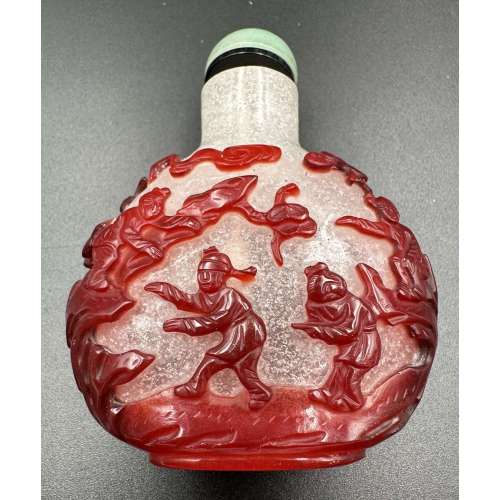 Overlay of red glass on snowflake glass snuff bottle, carved in relief with seven children playing in a landscape with rocks and trees, with aventurine stopper and black collar. Late 19th century Dimensions: H72 x W56 x D30 mm
Overlay of red glass on snowflake glass snuff bottle, carved in relief with seven children playing in a landscape with rocks and trees, with aventurine stopper and black collar. Late 19th century Dimensions: H72 x W56 x D30 mm -
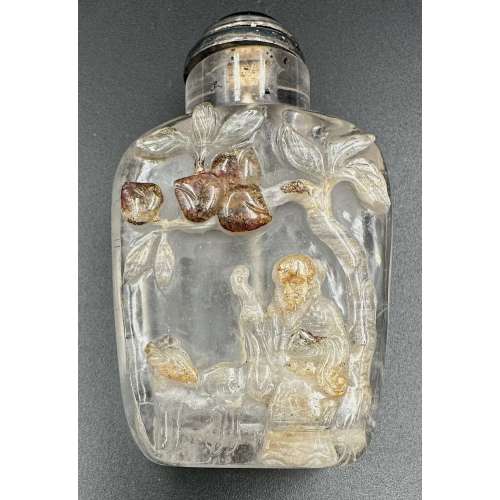 Snuff bottle made of rock crystal with brown skin carved with a sage and a deer under the peach tree on one side and a cuckoo on a plum tree on the other, with a chrysotile stopper and tin collar. Late 19th century. Dimensions: H68 x W40 x D21 mm.
Snuff bottle made of rock crystal with brown skin carved with a sage and a deer under the peach tree on one side and a cuckoo on a plum tree on the other, with a chrysotile stopper and tin collar. Late 19th century. Dimensions: H68 x W40 x D21 mm. -
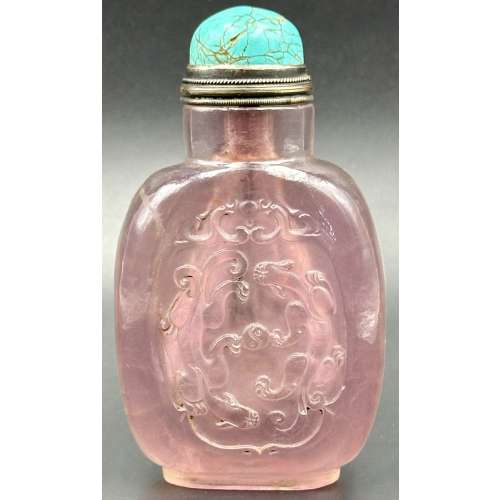 NEWRose quartz snuff bottle of rounded rectangular form on raised foot with round neck, carved in relief with a double dragon in a cartouche; round turquoise stopper with silver collar.
NEWRose quartz snuff bottle of rounded rectangular form on raised foot with round neck, carved in relief with a double dragon in a cartouche; round turquoise stopper with silver collar.The Eastern dragon is not the gruesome monster of medieval imagination, but the genius of strength and goodness. He is the spirit of change, therefore of life itself. Hidden in the caverns of inaccessible mountains, or coiled in the unfathomed depth of the sea, he awaits the time when he slowly rouses himself into activity. He unfolds himself in the storm clouds; he washes his mane in the blackness of the seething whirlpools. His claws are in the fork of the lightning, his scales begin to glisten in the bark of rain-swept pine trees. His voice is heard in the hurricane, which, scattering the withered leaves of the forest, a dragon quickens a new spring [C. A. S. Williams. Chinese Symbolism and Art Motifs / 3rd Revised Edition. — Rutland, Vermont & Tokyo, Japan: Charles E. Tuttle Company, 1993].
The Qing dynasty (1644–1911). Mid-19th century. Dimensions: H90 x W52 x D30 mm -
 Small six-lobed sancai (blue, amber, and cream) earthenware tripod censer with amber lead glaze mouth, an outer surface of the body decorated in a form of toad skin, the centre of the bottom unglazed, standing on unglazed beast's paws. China, the Tang dynasty [唐朝] (618 – 907). Diameter: 10.2 cm; Height: 9.2 cm.
Small six-lobed sancai (blue, amber, and cream) earthenware tripod censer with amber lead glaze mouth, an outer surface of the body decorated in a form of toad skin, the centre of the bottom unglazed, standing on unglazed beast's paws. China, the Tang dynasty [唐朝] (618 – 907). Diameter: 10.2 cm; Height: 9.2 cm.


